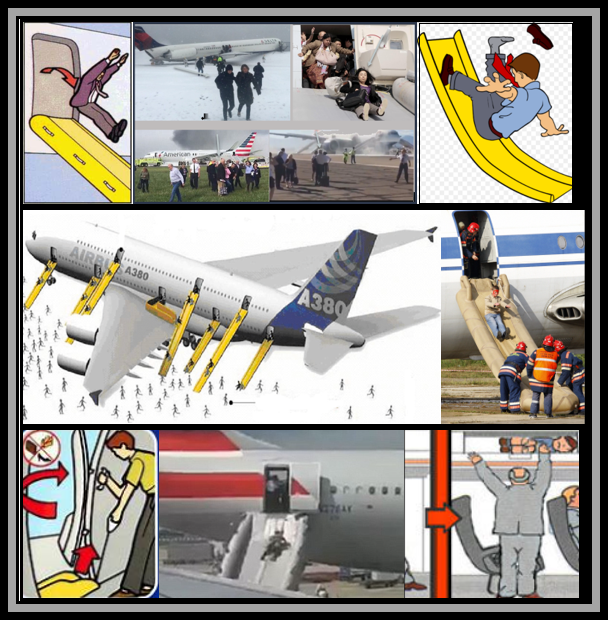Rep. Cohen’s FIVE YEARS repeating the same Question now may break ankles?

The people of Tennessee’s 9th Congressional District should recognize his persistence as witnessed by his January 29th Press Release (see below). As he notes, the Member of the House Transportation & Infrastructure Committee has been advocating that the FAA’s (and MOST OTHER CAAS’[1]) must revise its emergency evacuation standards (see 14 CFR § 25.803 (c)).
Below is a brief review of the Congressman’s five years of efforts:
O9.21.2018
OIG REPORT on Emergency Evacuations misses some relevant data
12.12.2022
Reality Check on the Emergency Vacating of Aircraft Cabin (EVAC) Act
04.06.2024
Attachment A is an excerpt of that history
Add to that long record, the FAA was mandated to institute a Emergency Evacuation Standards Aviation Rulemaking Committee (04/29/2019) .On 05/20/2020 the ARC issued 27 recommendations, none of which called into question the 90 second rule. This independent outside expert group completed an exhaustive study of 290 actual events (Appendix 3- List of Evacuation Events Reviewed), the passengers on which must be considered as representative of the general population.
On 08/ 03 /2022. the FAA issued a Request for Comments in Minimum Seat Dimensions Necessary for Safety of Air Passengers (Emergency Evacuation). The docket includes 26,102 comments. Perhaps the Congressman would like to see the results of the public’s input on this technical issue?
In light of the Member’s CURRENT RECOMMENDATION that his constituents comment on the issue, Leave Your Feedback on Airplane Seat , well after the close of the comment period, MAYBE some from TN 9 will submit. Wait for it?
A little on the substance of Rep Cohen’s proposal. To get to the result that he asserts is the RIGHT answer, he insists that the following be subjected to the real-life emergency evacuation test:
· people over the age of 60,
· individuals under the age of 18 including lap children,
· individuals with disabilities, including those who use wheelchairs, service animals, significantly overweight individuals,
· Individuals whose primary language is not English,
· or any carry-on baggage.
Consider what the Representative is asking. The test loads a simulated cabin with the “test objects”, then injects a realistic level of smoke and finally starts the emergency evacuation process—cabin crew opening emergency exits and yelling instructions. Then,
- an 80-year-old successfully slides down an evacuation chute;
- a passenger and service dog also exit well;
- an overweight passenger slides down, but breaks his ankle;
- a wheelchair passenger abandons the chair, makes it to the bottom and is assisted by someone on the ground;
- a teenager seeing this as a bit of a lark jumps on the slide and bounces from its safe channel and dislocates a shoulder;
- a passenger ignores the prohibition against taking carry-ons and the sharp of the bag slices the slide, causing the next 2 passengers on the chute to fall to the ground and injuries are incurred;
- a person with a mental disability, who has been thoroughly briefed, is traumatized and will never flight again;
- a father holding a baby doll (no one in their right mind would allow an infant to participate), descends too fast and to slow his speed, brakes with his hand and at the bottom, breaks his hand.
The FAA, the US Government, would BE LIABLE FOR THE INJURIES incurred through REP. COHEN’S PRESCRIBED LIST OF MANDATED TEST SUBJECTS.

Congressman Cohen Asks FAA Administrator to Reevaluate 90-Second Aircraft Evacuation Standard

January 29, 2024
Urges immediate action in light of Senate inaction on FAA reauthorization.
WASHINGTON – Congressman Steve Cohen (TN-9), the Ranking Member of the Aviation Subcommittee, and a longtime advocate of advancing aircraft safety, today wrote to Federal Aviation Administration Administrator Michael Whitaker asking him to have CURRENT AIRCRAFT EVACUATION STANDARDS reevaluated in light of the January 2 JAPAN AIRLINES FLIGHT 516 collision with a Japan Coast Guard plane.
INSERT:

The letter reads in part:
“While I recognize that the investigation is ongoing, it is widely reported that it took 18 minutes for the airline crew to evacuate the flight’s 367 passengers. The airplane involved in the accident, an Airbus A350-900, was certified to evacuate up to 440 passengers within 90 seconds with only half of the exits usable. While I certainly applaud the crew for evacuating the plane before the tragedy worsened, this accident should serve as a warning to reevaluate our standards before another accident occurs.
“I have LONG BEEN CONCERNED about whether the FAA’s evacuation standards consider realistic circumstances such as passenger demographics, mobility, and behaviors. In 2016, I introduced the Safe Egress in Air Travel (SEAT) Act with Representative Adam Kinzinger, and in 2017, we reintroduced the bill with Senators Richard Blumenthal, Chuck Schumer, Ed Markey, Bob Menendez and Dianne Feinstein. During the FAA reauthorization process in 2017, I introduced the SEAT Act as an amendment, which was ultimately included in the final 2018 FAA reauthorization bill that became law.
“Section 577 of the 2018 FAA reauthorization bill requires the Administrator to establish minimum seat size and distance between rows of seats on commercial aircraft to protect the safety of the flying public, which I’ll note is still not completed…
“To gather data in furtherance of the agency’s implementation of Section 577, and in further compliance with Section 337, the FAA conducted SIMULATED EMERGENCY EVACUATIONS at the Civil Aerospace Medical Institute (CAMI) in late 2019 and 2020, well after the one-year deadline. This testing did not include evaluation of passengers who are representative of the flying public, including PEOPLE OVER THE AGE OF 60, INDIVIDUALS UNDER THE AGE OF 18 INCLUDING LAP CHILDREN, INDIVIDUALS WITH DISABILITIES, INCLUDING THOSE WHO USE WHEELCHAIRS, SERVICE ANIMALS, SIGNIFICANTLY OVERWEIGHT INDIVIDUALS, INDIVIDUALS WHOSE PRIMARY LANGUAGE IS NOT ENGLISH, OR ANY CARRY-ON BAGGAGE. Then-FAA Administrator Steve Dickson even conceded the tests ‘provide useful, but not necessarily definitive information…’
Added Rep. Cohen-“The CAMI study made clear that our current 90-second evacuation standard may be inadequate, and the recent Japan Airlines event seems to further validate its inadequacy. I have partnered with Senator Tammy Duckworth, Chair of the Subcommittee on Aviation Safety, Operations and Innovation, in introducing The Emergency Vacating of Aircraft Cabin (EVAC) Act to ensure that the FAA does more to prioritize passenger safety by appropriately considering carry-on baggage, people with disabilities, seniors and children in its emergency evacuation standards. In my role as Ranking Member of the Aviation Subcommittee, I have also worked with T&I Committee Ranking Member Rick Larsen and our counterparts to include a version of the EVAC Act in the House -passed FAA reauthorization to direct the FAA to task the Aviation Rulemaking Advisory Committee with proposing updates to aircraft evacuation requirements…
“It should not be lost on anyone, especially regulators, that the evacuation of 367 passengers in 18 minutes where no one was injured or killed may be a rare instance. We should not put ourselves, the airline industry, or the flying public in a position to have to beat those odds again when we already have a real-world incident that demands change.”
See the entire letter here. [NOTE: The requested file was not found.]

Attachment A
O9.21.2018
OIG REPORT on Emergency Evacuations misses some relevant data
SM 09.21.2018 OIG REPORT on Emergency Evacuations misses some relevant data.docx
FAA response from OIG Appendix
The FAA has identified the following key points of disagreement with the draft report:
• Numerous requirements apply to evacuation, including addressing occupant protection, prolonging the time for egress, and enabling faster egress. The report is largely silent on these requirements and focuses only on what is addressed in the full-scale evacuation demonstration. Thus, the draft report creates the impression that the full-scale demonstration is the most important component; however, that conclusion is not consistent with a systems approach to the evaluation of evacuation requirements.
• FAA requirements address real world conditions by considering fires, landing gear collapse, and exit failure, among others.
• FAA retains selected evacuation data, including both test plans and reports, as well as the analyses. The FAA also has access to all certification data.
• Although the evacuation certification process is not covered by 14 CFR Part 5 Safety Management System (SMS) requirements, operators are required to identify hazards under SMS and mitigate them.
• Evacuation times in the accidents cited in the report bear no relation to the certification requirement for a given airplane. The certification standard is a benchmark, under a specific set of conditions, and is not relatable to an actual accident, unless all of the same conditions exist. In an actual event, the key parameter is whether the time required to evacuate is less than the time available to evacuate. The time required is particularly difficult to establish for evacuations in non-emergency conditions
———————————————-
Based on public opinion, seat size/pitch is coming; the end of data-based aviation safety rules ?
The FAA has issued an ANPRM asking the public for comments on safety standards on seat width, pitch and length. This Federal Register notice preemptively dismissed submissions on comfort and convenience because such considerations are beyond its statutory authorities
My employers, TC/STC FAR Part 25 applicants, expected that I would exercise my professional judgment to go beyond these minimum standards whenever possible, not just based solely on the company’s costs. Under that charge, I was knowledgeable about means of compliance to FAA regulations and relevant aeronautical engineering studies, literature on aircraft “Unplanned Events” fires, demographic studies and the actions of the world’s civil aviation authorities on this subject. Over that time, the FAA and other CAAs have modified the rubrics of these tests in ways intended to enhance the validity of these tests and to minimize the degree to which the individuals participating in these tests risk injuries in the evacuations. This would be accomplished by “alternate means of showing compliance” acceptable to the FAA administrator. It should be noted that during the present evacuation testing that the aisles are strewn with pillows, blankets, and other objects the test subjects must navigate through to reach the exits in the aircraft.
04.06.2024
Congressman demands FAA seat safety study-pitch is safe plus 12 evacuation recommendations -still disappointed
What were the bona fides of the Civil Aerospace Medical Institute’s study?
- Experts brought in to assure objectivity-
- “… the FAA chartered the Emergency Evacuation Standards Aviation Rulemaking (ARC), which met between October 2019 and May 2020. The ARC included dozens of aviation stakeholders, including the National Transportation Safety Board (NTSB), the European Union Aviation Safety Agency, FlyersRights, the Allied Pilots Association, and the Association of Flight Attendants …”
- What did the ARC recommend that CAMI do?
- “The ARC reviewed nearly 300 real-world[2] evacuation events that occurred over the previous decade. The ARC found the overall level of safety in emergency evacuations to be very high, but made 27 recommendations to the FAA related to how the safety of such evacuations could be improved
In addition to the §337 mandated items, the ARC decided to consider factors identified by the FAA as potentially affecting an evacuation.
The above 12 recommendations are valid responses to the ostensible purpose behind §337—safety of passengers during an emergency evacuation. #12 recognizes the underlying premise of the Congressman’s visible complaint- the changing diameter of airline passengers over time.
The ARC careful examination of 300 recent passenger disembarkation events constitute expert assessment of a populations typical airline flights TODAY. No need to then subject elderly, handicapped and child test objects to simulated drills and the validity of such a definition of SEAT tests has been endorsed by the ARC’s participants.
[1] EASA requires that all aircrafts meet certain emergency evacuation standards, including the ability to evacuate all passengers and crew within 90 seconds 1. The standards also require that emergency exits be clearly marked and that passengers be provided with clear instructions on how to evacuate the aircraft in the event of an emergency 1. UK CAA; The National Civil Aviation Agency (ANAC) aircraft type certificate applicant are required to demonstrate that an aircraft, in maximum density configuration, can be completely evacuated within 90 seconds using only half of the total number of emergency exits 2.
[2] With that sample size, it is HIGHLY likely that some of the passengers included “elderly travelers, children and people who have disabilities.”